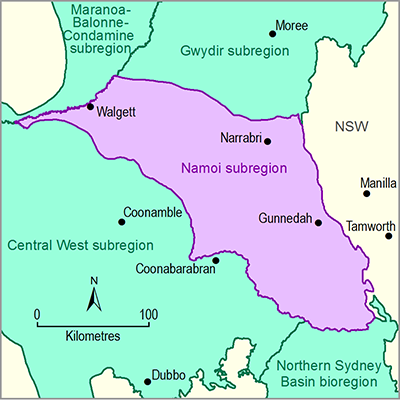- Home
- Assessments
- Bioregional Assessment Program
- Namoi subregion
- 2.3 Conceptual modelling for the Namoi subregion
- 2.3.5 Conceptual modelling of causal pathways
Summary
This section describes the causal pathways in the preliminary assessment extent (PAE) for the Namoi subregion. Causal pathways are the logical chains of events – either planned or unplanned – that link coal resource development and potential impacts on water resources and water-dependent assets.
A hazard analysis systematically identified activities that occur as part of coal resource development and may lead to potential changes in surface water or groundwater. Some of these hazards are beyond the scope of the bioregional assessments (BAs), such as accidents, and others are assumed to be adequately addressed by site-based risk management. Although individual hazards constitute causal pathways, these hazards can be aggregated by common impact cause and impact mode into four causal pathway groups:
- ‘Subsurface depressurisation and dewatering’. This causal pathway group has the potential to directly affect the regional groundwater system and the surface water – groundwater interactions in the near-surface groundwater areas of the Namoi River and associated streams. Open-cut coal mines may cause changes to hydraulic gradients due to mine pit dewatering, which may also affect surface water – groundwater interactions.
- ‘Subsurface physical flow paths’. Hydraulic fracturing, well integrity failure, and surface water – groundwater interactions associated with coal resource development affect this causal pathway group. Hydraulic fracturing may potentially alter inter-aquifer connectivity and introduce preferential flow paths, whereas poor well integrity may lead to enhanced connection between aquifer layers.
- ‘Surface water drainage’. Disruption of the surface water drainage may lead to a redirection in runoff with possible long-term cumulative effects on quantity and quality of the downstream surface water. It may also result from surface infrastructure associated with mining and coal seam gas (CSG) operations, including diversion of drain lines and on-site water retention.
- ‘Operational water management’. This causal pathway group includes the extraction of water for site management and operations, discharge of co-produced water to surface waters, usage for irrigation, and reinjection to depleted aquifers. It can have a cumulative effect on surface water conditions, stream networks, surface water – groundwater interactions and groundwater conditions.
The causal pathway groups relevant for the coal resource development pathway (CRDP) are the same for open-cut and underground coal mines and the CSG operations though the emphases within these potential causal pathways may differ.
The expected area of potential groundwater change is confined to the Liverpool Plains and the Pilliga and Pilliga Outwash. Surface water – groundwater interactions and potential surface water responses may occur in the streams of these geographic zones and those of the Castlereagh-Barwon geographic zone.
A landscape classification identified six major landscape groups. These are: ‘Dryland remnant vegetation’, ‘Floodplain or lowland riverine’, ‘Non-floodplain or upland riverine’, ‘Human modified’, ‘Springs’ and ‘Rainforest’. The causal pathway groups are all relevant to these six groups.

Product Finalisation date
- 2.3.1 Methods
- 2.3.2 Summary of key system components, processes and interactions
- 2.3.3 Ecosystems
- 2.3.4 Coal resource development pathway
- 2.3.5 Conceptual modelling of causal pathways
- Citation
- Acknowledgements
- Currency of scientific results
- Contributors to the Technical Programme
- About this technical product
